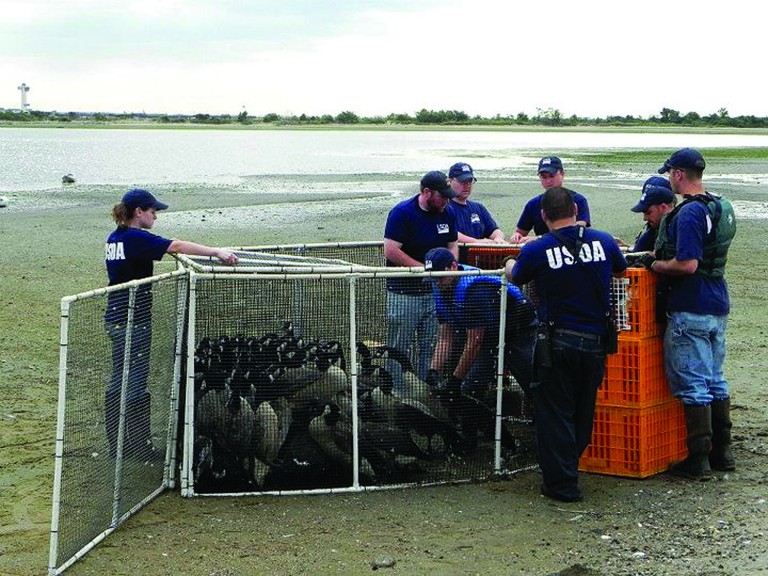
USDA agents round-up Canada Geese in the Jamaica Bay Wildlife refuge. 751 birds were targeted and loaded live into crates. They were then transported upstate to be euthanized and their meat processed. Photos Courtesy of Gateway National Recreation Center.
The Jamaica Bay Wildlife Refuge, whose website boasts “is one of the most significant bird sanctuaries in the Northeastern United States and one of the best places in New York City to observe migrating species,” seemed to be the complete opposite for 751 doomed winged-creatures on the morning of July 6.
In a decision approved by the the U.S. Department of Agriculture (USDA) and the U.S. Department of the Interior, federal agents, with the assistance of the Park Service, completed the culling of about half of the Refuge’s 1,500 Canada Geese population in a two day process.
Located in Broad Channel, in the shadow of JFK airport, the selective euthanization at the Refuge, came at the insistence of Senator Kristen Gillibrand (D-NY). She believes the effort will reduce the threat the birds pose to air travel. The Senator and other supporters cite the 2009 “Miracle on the Hud- son,” in which US Airways Captain Sully Sullenberger made a water landing after ingesting a large bird in the plane’s engine, as an example of bird related catastrophes.
“We are finally taking action to help reduce bird strikes and save lives,” said Gillibrand.
However, Jeffrey Kramer, a bird enthusiast from Bergen Beach, who has frequented the Wildlife Refuge for an indeterminable number of years, doesn’t buy the culling as a solution to aviation-bird issues.
“The bottom line is there are people like me who understand there is an overpopulation of geese in NYC, but to a very small degree are they correlated to airplane bird strikes? The fatality from bird strikes is very small. People like me feel like the geese are getting the raw end of the deal. There are others way to deal with this other than killing them,” said Kramer. “We have killed millions of birds [in the name of airplane safety] and still have a problem.”
David Karopkin, founder and director of GooseWatch NYC, an organization that formed about a year and a half ago and is currently seeking non-profit status as an advocacy group for the feathered creatures, also condemned the mass round-up as reckless, without merit, and lacking community involvement.
“This decision was handed down from [the] USDA; there was no public input. The science [behind claims] went unquestioned. They are not taking a real approach,” said Karopkin. “Not to minimize the event of a catastrophe, but birds are very low on the list. Nobody has ever died because of birds. Lots have died because of human error. These geese are being killed so the USDA and airports can say they are doing something. There are always alternatives that
are not being explored.”
Some of the alternatives that Karopkin advocates include: habitat management or making an area less attractive to birds and egg oiling, a method that controls populations by not allowing eggs to hatch.
The impassioned goose activist also said that after the “Miracle on the Hudson,” the National Transportation Safety Board issued a report with 33 recommendations for improvements to aviation safety and none included the removal of wildlife. Karopkin asserts he has experts to back him that instead of pouring resources into killing the birds, technilogical advancements such as adding light strips to the sides of airplanes, increasing the volume of engines, and using better radar will be far more effective in preventing bird-caused accidents.
John Warren, Public Affairs Specialist at Gateway National Recreation Area, which encompasses the refuge, acknowledged that there are alternative ways to control the goose population but said the culling was the most effective way to curb the issue with any sense of urgency.
“It’s always an unfortunate position to be put in. It is never something we do with any joy, but the safety of the human public is paramount,” said Warren, who was present on the day of the culling to take pictures for public transparency reasons.
Although this is the first time a culling of this nature has taken place in the Wildlife Refuge, Gateway authorized the round-up of around 200 geese in 2010 and 2011 in landfills along the north shore of Jamaica Bay.
The removal of the geese also benefits the park ecologically, according to Warren. The rehabilitation of the salt marshes where the Refuge is located have been slow-going because the geese rip up roots of plants used to restore the islands.
Warren also tried to placate op- position to the culling by stating the process was done in the most humane way possible. He said it took place during molting season, when the birds are shedding their feathers and therefore unable to fly away making them easier to be herded into penned areas. The geese were then crated live and transported to a food processing plant upstate where they were euthanized.
Their meat was then distributed to New York State food pantries for the homeless, much to the dismay of Kramer.
“I feel that was public relations ploy. I am not sure anyone would want to eat those geese. As far as food banks go, we can do a lot better for our homeless popula- tion than feeding them birds from sanctuaries,” he said.
While concerned advocates like Karopkin will continue to try and bring public attention to what he views as a “baseless and band-aid solution,” he hopes it also resonates as a bigger issue of how humans interact with wildlife.
“We are the ones putting big metal objects in the sky. It’s a balance to protect humans and wildlife. But right now, the geese are the ones being demonized.”
By Katie Riordan



